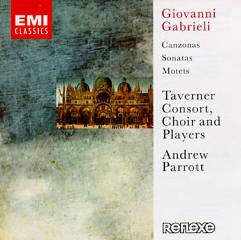Giovanni Gabrieli - Sonatas, Canzonas And Motets (1991)
Giovanni Gabrieli - Sonatas, Canzonas And Motets (1991)

1 Dulcis Jesu (a 20) 7:42
2 Sonata pian e forte (a 8) 5:18
3 Jubilate Deo (a 8) 4:16
4 Sonata (a 14) 6:04
5 O Jesu mi dulcissime (a 8) 4:51
6 Canzon (a 12) 3:25
7 Hic est filius Dei (a 18) 7:10
8 Sonata con tre violini 4:14
9 Sonata (a 22) 7:24
10 Miserere mei Deus (a 4) / Gloria Patri (a 8) 14:31
11 Canzon in echo duodecimi toni (a 10) 4:33
12 Audite principes (a 16) 6:23
Taverner Consort, Choir and Players
Andrew Parrott – conductor
The works of the Italian composer Giovanni Gabrieli (ca. 1557-1612) mirror the transition from the 16th-century Renaissance style to the 17th-centurybaroque. His compositions were very influential on Italian and German masters.
Giovanni Gabrieli was born in Venice. He was associated with the court chapel of Roland de Lassus in Munich (1576-1580). Despite this important contact, the formative influence on the young Giovanni was his uncle Andrea Gabrieli, whose career as composer and organist anticipated his own. Giovanni's devotion to Andrea is witnessed by a collection of concerti (1587) issued by the younger man from among his own works and those of the older man, dead but a year.
Like his uncle, Giovanni worked in the Cathedral of St. Mark in Venice, first as deputy to the famed master Claudio Merulo (1584), then as second organist (1585), and finally as first organist (1586). He also composed vocal and instrumental pieces for church and state festivities and taught a young generation of composers the new musical idioms of the baroque. He died in Venice on Aug. 12, 1612.
Only a few of Gabrieli's secular vocal pieces have survived. But a collection of madrigals by his student Heinrich Schütz, printed in 1611 as the fruits of an apprenticeship with Gabrieli, suggests that the teacher was deeply interested in the genre. Among Gabrieli's madrigals is the eight-voice Lieto godea for two choruses. Here, as in the sacred pieces, antiphonal effects, created by means of vertical, chordal combinations, replace the linear movement of the older polyphonists.
Many more of Gabrieli's instrumental pieces have survived, including numerous canzonas, ricercars, and sonatas. Some early canzonas such as La Spiritata are conventional, sectional pieces in imitative, multithematic polyphony. Several of the monothematic ricercars, on the other hand, are virtually forerunners of the latebaroque fugue. Of particular interest is Gabrieli's Sonata piano e forte, the first composition ever to bear this title. In addition to marking dynamics throughout the individual parts, the composer prescribed the instrumentation of the sonata—a novel departure from Renaissance practice, in which instrumentation was usually an ad libitum matter. Among his late instrumental pieces is a Sonata con tre violini e basso se piace, for which the master made the decisive turn to the basso continuo, the foundation voice of most baroque music.
Of all Gabrieli's works, first place must go to the motets. Polychoral writing (cori spezzati), as promulgated by Adrian Willaert and continued by Andrea Gabrieli, found its most brilliant exponent in Giovanni Gabrieli. In his collection Sacrae symphoniae (1597) there were motets for six to sixteen parts and arranged for one to four choruses. For these works he replaced the older, imitative, melismatic polyphony of the Franco-Flemish school by syllabic, harmonic writing. Bass parts moving in fourths and fifths supported separated choirs responding antiphonally to one another in short, declamatory phrases. For Gabrieli, who designed his creations for large spaces, traditional counterpoint was less important than dramatic changes in texture and dynamics.
Gabrieli's second volume of Sacrae symphoniae, printed posthumously (1615), contains early as well as late pieces in the new concerted idiom. Characteristic of the late compositions are the juxtaposition of voices and instruments, virtuoso solo writing, and the basso continuo.
The motet In ecclesiis reveals most of the innovations of Gabrieli's late style: solos and duets supported by organ (basso continuo) or instrumental ensemble; a solo quartet of voices responding to or joining the chorus; and instrumental ensembles accompanying the singers or playing independent sinfonie. With such a work resplendent with color, Gabrieli helped inaugurate a new musical epoch that was carried forward by many 17th-century Roman masters and, even more significantly, by the Germans Heinrich Schütz and Michael Praetorius. ---yourdictionary.com
download: uploaded anonfiles yandex 4shared solidfiles mediafire mega filecloudio
Zmieniony (Niedziela, 17 Listopad 2013 23:33)








